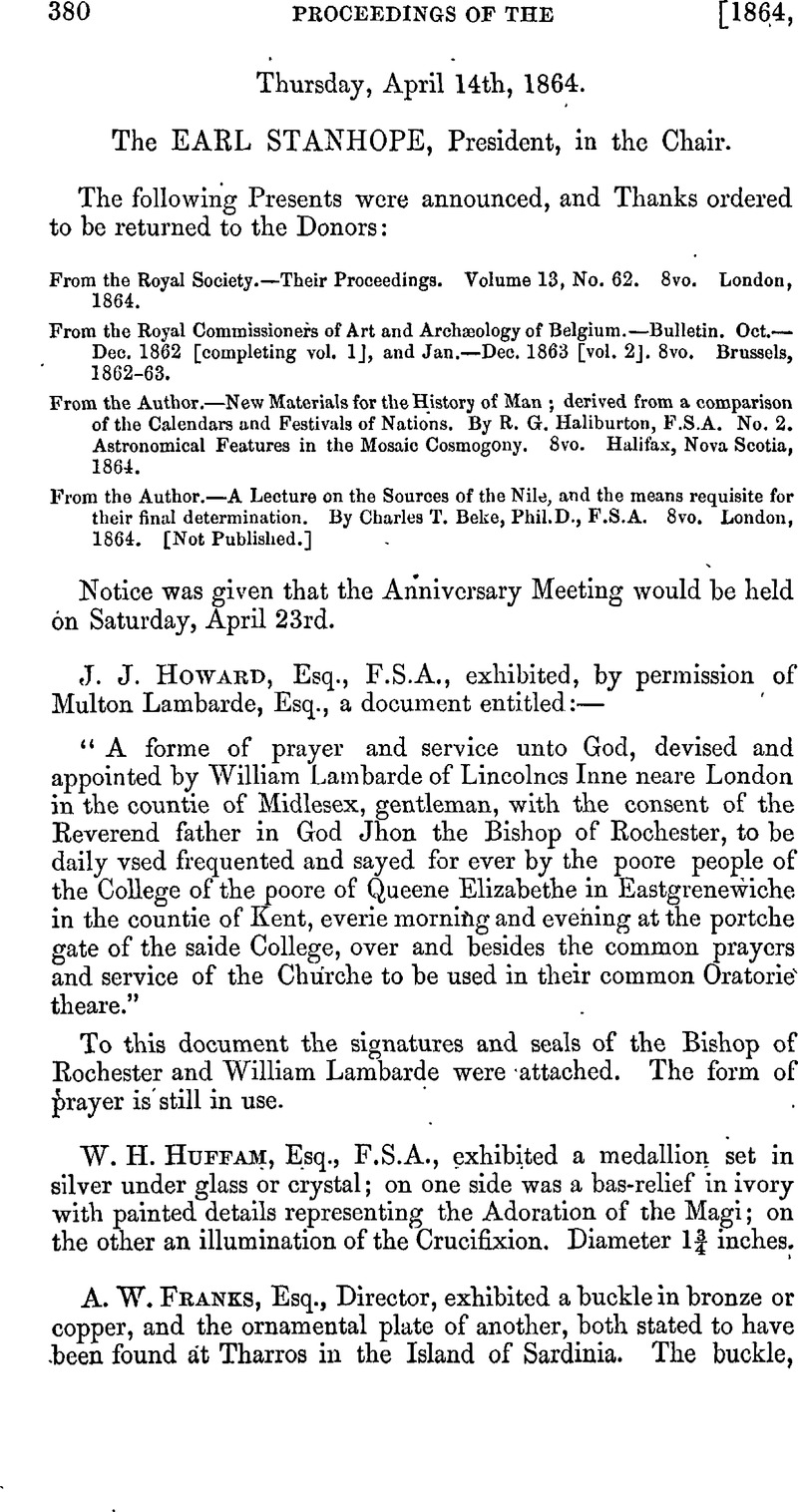No CrossRef data available.
Article contents
Thursday, April 14th, 1864
Published online by Cambridge University Press: 10 May 2010
Abstract

- Type
- Proceedings
- Information
- Copyright
- Copyright © The Society of Antiquaries of London 1864
References
page 383 note * Their names are given in the will of William Bliton, of Kirton, which was executed 7 Feb. 1498. I quote from a contemporary transcript in private hands. “It'm, gilde sepulchri d'ni nʼri Jʼhu Xpʼ1 in eadʼ xij d. It'm, gilde sʼcʼi Johis Baptiste in eadʼ Ecclʼia xij d. It'm, gilde Corpʼis Xpʼi in eadʼ Ecclʼia xij d. It'm, gilde ib'm vocatʼ May gilde xij d. It'm, gilde ibʼm vocʼ pluygh gilde xij d.” The fresco recently discovered in this church which was destroyed as soon as found (Proceedings of Society of Antiquaries, 20th June, 1861), was probably a picture decorating the altar of one of these gilds. It is probable, too, that much of the stained glass which formerly ornamented the windows of this church owed its origin to these societies. In the neighbouring parish church of Blyton there used to exist a window inscribed “Priez for ye gild of Corpus Xʼri quilk yes Window garte mak.”—Harl. MS. 6829, f. 149.
page 384 note * i.e. Thomas of the hall.
page 384 note † i e. At the church stile.
page 384 note ‡ The family of Burgh, alias Borowe, of Kirton in Lindsay, was a younger branch of the noble house of Burgh of Gainsborough, barons by writ 1487–1601. The Kirton branch became extinct in the male line temp. Jacobi I. Elizabeth Burgh the heiress of the blood only, for the estates had melted away, married John Shaw of Bottesford, where she was buried a.d. 1655.
page 385 note * Croylle, that is cruel, an old word for worsted. The great chamber at Holy Island in 1533 was hung “cum lo red crole et borders.” Raine's North Durham, 126.
page 386 note * The church headlands were lands set apart in the open fields for the use of the church wardens.
page 386 note † This probably has reference to digging paving “cobbles” on Hardwick Hill, a large hill of gravel and sand on Scotton Common, near the bank of the river Trent.
page 386 note ‡ Bainton is a common surname in this neighbourhood. Roche Abbey is probably the place indicated. It is believed that tho quarries at that place supplied many of the Lindsey churches with building stone.
page 386 note § See Nichols's Illustrations, &c. from Church wardens' Accounts, p. 200.
page 386 note ‖ A basket for holy bread, or Eulogia. This was ordinarily leavened bread blessed by the priest after mass, cut into small pieces, and distributed amongst the people. It had no connection with the sacramental bread, but was used as a symbol of the brotherly love that ought to exist among Christians. When the practice originated it is not easy to tell. Laur. Beyerlinck May. Theat. Vitæ Humana: mdcclxxiix. t. i. pp. 405–408. Our ancestors were much attached to this ancient rite. One of the demands of the Devonshire men in 1549 was “we will have holy bread and holy water every Sunday.”—Crammer's Works, 1844, vol. i. p. 176. And when these same rebels laid siege to Exeter they carried before them “the pix, or consecrated host borne under a canopy with crosses, banners, candlesticks, holy bread, and holy water.” —Heylin, Eccl. Restaurata, ed. 1849, vol. i. p. 158. Baskets for holding blessed bread were in existence in Lincolnshire as late as tho 8th of Elizabeth. The following memorandum relating to the parish of Gronwarby has been preserved: “one hally bred skeppe sold to Mr Allen, and he makethe a baskett to carrie fiishe in.”
page 386 note ¶ Probably a sanctus bell. No indications now remain of any ancient vestry.
page 387 note * Small sticks for fuel. We find in 1648— “Item to blinde Sutton's wife for elding, 1 s ”
page 387 note † Culverin.
page 388 note * These bells are not now in existence. They were recast by J. Harrison, of Barton-upon-Humber, in 1798.
page 388 note † In the year 1616 the “Porcarius villæ” occupied a house upon the waste of iij s. iiij d. value. Joh. Norden's Survey of Kirton Sake, MS. Cantab. Ff. 4, 30, fol. 2 B. This was considered a usurpation, on the part of the town, of the rights of the Lord of the Manor.
page 388 note ‡ The anniversary of the accession of King James.
page 388 note § A ladder.
page 388 note ‖ Charles II. born 29th May, 1630.




